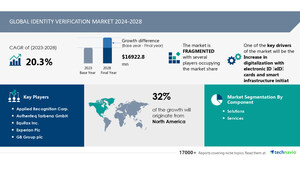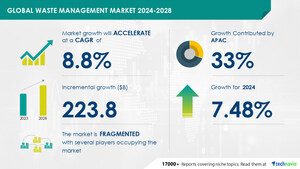NEW YORK, March 4, 2024 /PRNewswire/ -- The printed electronics market size is set to grow by USD 47,.58 billion during 2022-2027, progressing at a CAGR of 15% during the forecast period, according to Technavio Research. The report offers an up-to-date analysis regarding the current market scenario, latest trends and drivers, and the overall market environment. The growing demand for flexible displays will notably driving the printed electronics market growth during the forecast period. OLED displays have superior display characteristics and superior viewing angles compared to currently available alternative technologies. Besides, LCD and EPD-based flexible displays are gaining popularity in the market. Furthermore, TVs with curved liquid crystal displays are also on the market. Other new applications for flexible displays, including kiosks, tablets, notebooks, e-readers, smart glasses, etc., are also expected to drive the demand for this technology during the forecast period. View PDF Sample
Market Report Coverage |
Details |
Page number |
178 |
Base year |
2022 |
Historic period |
2017-2021 |
Forecast period |
2023-2027 |
Growth momentum & CAGR |
Accelerate at a CAGR of 15% |
Market growth 2023-2027 |
USD 47.58 billion |
Market structure |
Fragmented |
YoY growth 2022-2023(%) |
14 |
Regional analysis |
APAC, North America, Europe, Middle East and Africa, and South America |
Performing market contribution |
APAC at 48% |
Key countries |
US, South Korea, Japan, China, and UK |
Although the Growing demand for flexible display | Rising use of NFC | Increasing demand for printed electronics in automotive and transportation will offer immense growth opportunities, is likely to pose a challenge for the market vendors. In a bid to help players strengthen their market foothold, this printed electronics market forecast report provides a detailed analysis of the leading market vendors. The report also empowers industry honchos with information on the competitive landscape and insights into the different product offerings offered by various companies. The report offers an up-to-date analysis regarding the current market scenario, the latest trends and drivers, and the overall market environment. For more insights on CAGR and YOY growth rate, View PDF Sample
Segmentation Overview
Printed Electronics Market is segmented as below:
- Technology
- Screen
- Inkjet
- Gravure
- Flexographic
- Application
- Display
- Sensors
- Photovoltaics
- Battery
- Others
- Geography
- APAC
- North America
- Europe
- Middle East And Africa
- South America
The screen segment was valued at USD 16,393.64 million in 2017 and continued to grow until 2021. Screen printing is a popular technology widely used in the market, especially for applications such as flexible displays, photovoltaics, and touch screens. Therefore, the screen segment is expected to further enhance the performance and versatility of screen printing for the market during the forecast period. To learn more about all segments impacting the future of market research, download a sample.
Vendor Analysis
- The market is highly competitive due to the presence of many vendors. There are significant growth opportunities in the market as they are finding numerous applications in different electronic devices. Although achieving economies of scale in flexible display production is posing a challenge for vendors in the market, the cost of manufacturing printed electronics is very low. Hence, it is allowing significant growth opportunities for small- as well as large-scale vendors in the market during the forecast period.
The emergence of stretchable electronics is a key trend influencing the market growth. The existence of alternatives to printed electronics and the high penetration of products manufactured using alternative manufacturing techniques are certain factors hindering the market growth. Download a sample.
Analyst Review
The market has witnessed remarkable growth, fueled by technological innovations across various industries such as automotive & transportation and consumer electronics. Leveraging the Internet of Things (IoT), screen printing technology, and advanced sensors, this sector has experienced a paradigm shift, offering novel solutions in display technologies, photovoltaic (PV) cells, and inks material segments.
Among the notable advancements, metal-based inks have gained prominence, particularly in the realm of conductive inks. Silver conductive inks, renowned for their high conductivity, have become a cornerstone in printed electronics, enabling the development of intricate circuitry and robust electronic components. This has revolutionized the automotive & transportation end-use industry, facilitating the integration of thin-film PV cells into vehicle structures, thereby enhancing energy efficiency and reducing fuel consumption and carbon emissions.
Furthermore, the emergence of OLED lighting solutions has reshaped the landscape of display technologies, offering superior brightness and energy efficiency compared to traditional methods. In tandem with this, molded electronics have garnered attention for their ability to seamlessly embed electronic functionalities into various surfaces, paving the way for innovative automotive interiors and consumer electronics.
Organic solar cells represent another significant breakthrough in the realm of photovoltaic (PV) cells, offering flexibility and cost-effectiveness for diverse applications. These cells hold immense potential in addressing energy challenges in both urban and remote settings, contributing to sustainable development efforts globally.
Amidst these advancements, the focus on sustainable practices is paramount. The utilization of environmentally friendly materials, such as metal-based inks and conductive inks, underscores the industry's commitment to reducing its ecological footprint while driving technological progress.
In conclusion, the market continues to thrive on a trajectory of innovation, propelled by breakthroughs in technological innovations and collaborative efforts across industries. As IoT integration becomes more pervasive and sensors become increasingly sophisticated, the possibilities for printed electronics are boundless, promising a future where energy-efficient, interconnected devices redefine the way we live, commute, and interact with technology. Download a sample.
Related reports -
The flexible printed circuit board market share is expected to increase by USD 1.64 billion from 2021 to 2026, and the market's growth momentum will accelerate at a CAGR of 3.73%.
The printed circuit board (PCB) market is estimated to grow at a CAGR of 5.05% between 2022 and 2027 reach USD 19,059.2 million.
Table of Contents:
1 Executive Summary
2 Market Landscape
3 Market Sizing
4 Historic Market Size
5 Five Forces Analysis
6 Market Segmentation by Technology
7 Market Segmentation by Application
8 Customer Landscape
9 Geographic Landscape
10 Drivers, Challenges, and Trends
11 Company Landscape
12 Company Analysis
13 Appendix
About US
Technavio is a leading global technology research and advisory company. Their research and analysis focuses on emerging market trends and provides actionable insights to help businesses identify market opportunities and develop effective strategies to optimize their market positions. With over 500 specialized analysts, Technavio's report library consists of more than 17,000 reports and counting, covering 800 technologies, spanning across 50 countries. Their client base consists of enterprises of all sizes, including more than 100 Fortune 500 companies. This growing client base relies on Technavio's comprehensive coverage, extensive research, and actionable market insights to identify opportunities in existing and potential markets and assess their competitive positions within changing market scenarios.
Contact
Technavio Research
Jesse Maida
Media & Marketing Executive
US: +1 844 364 1100
UK: +44 203 893 3200
Email: [email protected]
Website: www.technavio.com/
SOURCE Technavio

WANT YOUR COMPANY'S NEWS FEATURED ON PRNEWSWIRE.COM?
Newsrooms &
Influencers
Digital Media
Outlets
Journalists
Opted In




Share this article